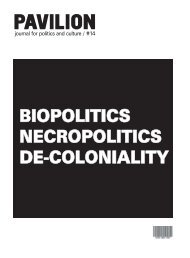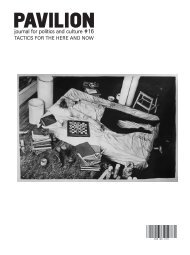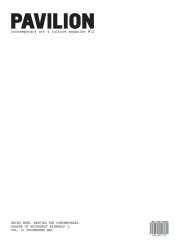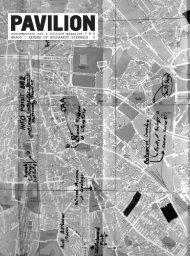PAVILION
PAVILION
PAVILION
- No tags were found...
Create successful ePaper yourself
Turn your PDF publications into a flip-book with our unique Google optimized e-Paper software.
ory, oral archive - testimony, written archive - documents, fictional archive. The personal histories<br />
of the residents are documented and mixed with factual historical material, using several<br />
techniques - photography/film/video material/audio recording/music/testimonies.<br />
The goals of the performance are: sharing information and creative experiences between<br />
tangaProject group and the community of the residents; researching/revaluing of the historical<br />
event. The performance is part of 4th Age community art programme developed by tangaProject<br />
together with the inhabitants of Moses Rosen residence for seniors, since 2009. The major goal<br />
of the programme is changing the attitude towards agedness in the Romanian society.<br />
The team: Paul Dunca, Cinty Ionescu, Monica Marinescu, Mihaela Michailov, Ioana Păun, David<br />
Schwartz, Constantin Vică, Bianca Brif.<br />
Evenimentul îşi propune investigarea performativă a istoriei din perspectiva relevanţei<br />
unui eveniment major în plan colectiv şi individual, eveniment care a generat mutaţii semnificative<br />
la nivel de existență privată şi publică.<br />
Un an-cheie în istoria comunităţilor evreieşti din România devine pilonul cercetării performative<br />
pe care echipa tangaProject o realizează împreună cu rezidenţii Căminului de vârstnici<br />
Moses Rosen. 1944, 23 august - Prim-ministrul României, Ion Antonescu este arestat şi se<br />
formează un nou guvern. România părăseşte războiul împotriva Uniunii Sovietice şi se alătură<br />
forţelor aliate. Ocupaţie sovietică/Implicarea în lupta contra Germaniei naziste/Venirea comuniştilor/Un<br />
nou început/Trădarea aliaţilor de război/Înlăturarea regimului dictatorial al lui<br />
Antonescu. Tu ce faceai? Evenimentul este axat pe arhivarea performativă a memoriei, arhivă<br />
orală - mărturii, scrisă - documente, ficţională. Istoriile personale ale rezidenţilor sunt documentate<br />
si mixate cu materiale istorice factuale, folosind diverse medii - fotografie/film/material<br />
video/înregistrare audio/muzică/mărturii.<br />
Obiectivele evenimentului sunt schimbul de informaţii şi experienţe creative între<br />
echipa tangaProject şi comunitatea rezidenţilor şi cercetarea/redimensionarea evenimentului<br />
istoric. Evenimentul face parte din proiectul tangaProject Vârsta 4 - proiect de artă comunitară,<br />
început în 2009 şi desfăşurat împreună cu rezidenţii căminului Moses Rosen, al cărui obiectiv<br />
major este schimbarea receptării asupra bătrâneţii în societatea românească.<br />
Echipa Vârsta 4 : Paul Dunca, Cinty Ionescu, Monica Marinescu, Mihaela Michailov, Ioana Păun,<br />
David Schwartz, Constantin Vică, Bianca Brif.<br />
Comparative Art History: The Biennale Principle<br />
A conference on the history, present and future of art biennales<br />
Panel discussion<br />
Venue: National University of Arts, 28 Calea Griviței - in the lecture hall.<br />
In cooperation with the Swiss Institute for Art Research in Zurich (SIK-ISEA), Bucharest Biennale<br />
will host an international conference on the ›Biennale Principle‹. The agenda will address the<br />
genealogical aspects of Art Biennales by discussing the history of the Venice Biennale, as well<br />
[514]<br />
as the present and future conditions of Art Biennales such as the Bucharest Biennale. The conference<br />
is based on the assumption that Art Biennales are foremostly Janus-faced. On one hand,<br />
they are part of the globalized art market and perpetuate its structures, rites and conventions -<br />
the homogenizing effect of Biennales. On the other hand, they often highlight local, regional or<br />
national idiosyncrasies - the heterogenizing effect of Biennales.<br />
At SIK-ISEA, a team of international researchers is currently exploring the history of the Venice<br />
Biennale with a focus on the Swiss and various Middle-European pavilions. As the first Art<br />
Biennale ever, the Venice Biennale is a promising case study for the above implied dialectics of<br />
universalism - exceptionalism. Since its beginnings, the exhibition at the Giardini in Venice has<br />
served as an arena for bringing various nations together and engaging them in discourse. At the<br />
same time, it shed light on or even ignited rivalries between nations. As a heir of the World Fairs<br />
in the field of art, the Venice Biennale displays the same simultaneity of competition/mutual<br />
exchange, universalism/exceptionalism, inclusion/exclusion as its predecessors.<br />
While curators, artists and politicians often pursued quite different or even incommensurable<br />
objectives, depending on their respective cultural backgrounds, the Venice Biennale was and is<br />
altogether a more or less conservative, consensus-oriented event. In most cases, the art nations<br />
involved follow(ed) the dominant narratives of art history and the dominant international artistic<br />
styles in order to adapt to the cultural lead currencies. Marginal progressivist avant-garde movements<br />
were hardly ever considered, whereas in recent times, the label ›avant-garde‹ has become<br />
institutionalized, pacified and absorbed in mainstream discourse.<br />
On a structural level, the Venice Biennale was (and to this day is) based on a comparative<br />
scheme, realized through national pavilions, thus allowing for the association and disassociation<br />
of cultural policies and aesthetic programmes. However, the assembly of national pavilions does<br />
not provide insight into the ›nature‹ or ›essence‹ of nations, but rather into the manifold ways of<br />
constructing, inventing and representing concepts of (inter-, trans-)national or (inter-, trans-)cultural<br />
identities.<br />
One of the most promising research methods for exploring the Venice Biennale and its various<br />
contemporary successors is »Comparative Art History«. This methodological approach has<br />
recently been coined by Piotr Piotrowski (Uniwersytet im. Adama Mieckiewicza, Poznan, Poland)<br />
who also speaks of »horizontal art history« as opposed to »vertical art history«. The latter implies<br />
a certain dominance of the Western cultural centers over the so called ›peripheries‹ or ›margins‹<br />
in East-Central Europe. Comparative Art History seeks to abolish such implicitly judgmental hierarchies<br />
by highlighting the specific modes of local and regional art reception and art production.<br />
It allows for the analysis of unity and diversity at the same time.<br />
Precisely looking behind the curtains of the ›Biennale Principle‹ casts universalist notions of art<br />
history into doubt and demands the renunciation of homogenizing, self-contained narratives of<br />
art history. The question is not only: who and what was shown at this Biennale or that Biennale?<br />
But also: what was not shown? And why was it not shown? Moreover, it is evident that certain<br />
styles and discourses indeed have transcended - and more than ever do transcend - national<br />
boundaries, but nevertheless take on different meanings in different social, political and cultural<br />
contexts.<br />
In summary, the conference will address and discuss the potentials of Comparative Art History in<br />
the field of Biennale studies, starting from the Swiss pavilion in Venice, continuing with lectures<br />
on further national pavilions (see below) and finally tracing the modifications and variations of the<br />
›Biennale Principle‹ by the example of more recent Biennales such as the Istanbul Biennale or<br />
the Bucharest Biennale.<br />
Speakers:<br />
Zdenka Badovinac (SLO, curator and art historian, keynote lecture), Natasha Becker (USA, art<br />
historian), Marcus Graf (D/TR, art historian), Annika Hossain (CH, art historian), Regula<br />
[515]








